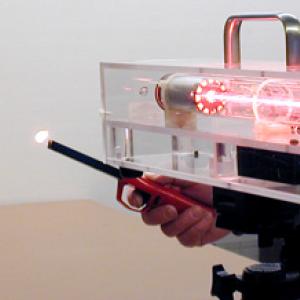College of Liberal Arts & Sciences
6A40.47 - Refraction - Twinkling Planets and Stars
Shine the laser on a distant wall or screen. Place a hot plate or the grill lighter directly under the beam and close to the laser. The image of the spot on the wall will be be steady until heat is applied after which it will appear to move, shimmer, and twinkle. This is due to the change in refractive index of the air through which the beam moves. The same effect takes place when viewing stars through the atmosphere.
A second effect is also observable. Mark the place on the wall where the laser beam spot is initially. Then move the hot plate under the laser beam. You will observe that the laser spot moves very visibly upward due to traveling through the less dense hot air above the hot plate.
- Sarah Lynn McGregor, Keith Goodale, "Demonstrations of Atmospheric Scintillation: Stars vs. Planets", TPT, Vol. 63, #2, Feb. 2025, p. 134.
- Lorne Whitehead, John Huizinga, and Michele Mossman, "Why do Stars Twinkle, and do they Twinkle on Mars?", AJP, Vol. 80, #11, Nov. 2012, p. 980.
- C. L. Enloe, M. L. Brake, and T. E. Repetti, "Laser Deflection Through a Spark", AJP, Vol. 58, #4, Apr. 1990, p. 400.
- Lauren Richey, Bailey Stewart, Justin Peatross, "Creating and Analyzing a Mirage", TPT, Vol. 44, # 7, Oct. 2006, p. 460.
- Daniel Engber, "Why Do Stars Really Twinkle?", Popular Science, Vol. 287, #5, Nov. 2015, p. 65.
- James C. Kernohan, "Astronomy Demonstrations: 5. Twinkling of Stars", PIRA News, Vol. 9, #3, Jan. 1995, p. 22.
- "O-226. Laser Dance Across Hot Plate", DICK and RAE Physics Demo Notebook.
- "O-225. Star Twinkle with Hot Plate", DICK and RAE Physics Demo Notebook.
- Jearl Walker, "6.33, Shadow Bands", The Flying Circus of Physics Ed. 2, p. 254 - 255.
- Jearl Walker, "6.32, Shimmy and Twinkling Stars", The Flying Circus of Physics Ed. 2, p. 254.
- Julien Clinton Sprott, "6.4. Twinkling Stars", Physics Demonstrations, ISBN 0-299-21580-6, p. 240 - 241.
- Janice VanCleave, "73, Twinkling Star", Janice VanCleave's Astronomy for Every Kid, p. 158 - 159.
- Janice VanCleave, "23, Twinkling Star", Janice VanCleave's 202 Oozing, Bubbling and Bouncing Experiments, p. 15.
- M. Minnaert, "44. Shadow Bands", Nature of Light and Color in the Open Air", p. 71 - 73.
- M. Minnaert, "43. Scintillation of Planets", Nature of Light and Color in the Open Air", p. 70 - 71.
- Sara Stein, "The Sun Appears Before It Rises", The Science Book, p. 192.
- Julius Sumner Miller, Q214 & A214, Millergrams II – Some More Enchanting Questions for Enquiring Minds, p. 65 & 113.
Disclaimer: These demonstrations are provided only for illustrative use by persons affiliated with The University of Iowa and only under the direction of a trained instructor or physicist. The University of Iowa is not responsible for demonstrations performed by those using their own equipment or who choose to use this reference material for their own purpose. The demonstrations included here are within the public domain and can be found in materials contained in libraries, bookstores, and through electronic sources. Performing all or any portion of any of these demonstrations, with or without revisions not depicted here entails inherent risks. These risks include, without limitation, bodily injury (and possibly death), including risks to health that may be temporary or permanent and that may exacerbate a pre-existing medical condition; and property loss or damage. Anyone performing any part of these demonstrations, even with revisions, knowingly and voluntarily assumes all risks associated with them.
